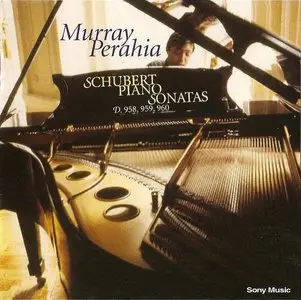Schubert · Piano Sonatas D 958, 959, 960 · Murray Perahia
Classical | EAC | FLAC+CUE | 344 MB
2 CDs | Covers | rs.com | 2003
Murray Perahia's intelligent musicianship, lyrical gifts, and cogent architecture make some of his live Schubert performances among the most memorable I've heard. These qualities inform his recordings of the composer's last three sonatas. The A major D. 959 holds particular interest in light of Perahia's earlier CBS recording from 1987. The pianist now opts for the first-movement repeat and generally conveys more sweep and inner urgency, making less of local details yet orchestrating the music with a wider variety of articulations and dynamic shadings. Notice, for example, the added finesse with which Perahia clarifies the left-hand detached notes against the right-hand legato in the first-movement recapitulation, plus the stronger rhythmic backbone he gives the Scherzo this time around. While both recordings of the slow movement time out to 8:05, don't assume they're identical: not at all! Perahia's interpretation has grown tauter and less editorialized, yet somehow the music's anguish intensifies, especially in those extraordinary outbursts of chromatic runs. What's more, Perahia's soft playing (in all three sonatas, actually) unfailingly conveys warmth and body, avoiding Mitsuko Uchida's self-conscious brand of sensitivity.
In the C minor sonata, Perahia's scrupulously gauged crescendos, diminuendos, and scales approach Richter's unflappable, equally un-self-regarding virtuosity. For all the richness and diversity of texture Perahia brings to the B-flat sonata's sprawling first movement, the mood is brusque and unsettled rather than otherworldly (à la Kempff and Lupu), abetted by the pianist's fleeter than usual basic tempo. He sustains the slow movement well–but without Richter's hypnotic steadiness or Rubinstein's songful tenderness. Likewise, the Scherzo's unpredictable phrase structures plus the Finale's demonic undercurrents emerge with slightly more spontaneity and character in the Pollini and Lupu recordings.
Still, I like how Perahia launches right into the Finale's opening unison G-natural as if to shatter the mood of the music that came right before. And shatter is the operative word when it comes to Perahia's unrelenting approach to the central dotted episode, delivered with steel-edged definition. While Perahia's last three Schubert sonatas may not displace my reference versions or other long-held catalog favorites, they reveal beyond question how this pianist's artistry refuses to stand still.
–Jed Distler, ClassicsToday.com
CD 1
Franz Schubert (1797-1828)
Sonata for Piano in C minor, D 958
Sonata for Piano in A major, D 959
CD 2
Sonata for Piano in B flat major, D 960
Franz Schubert (1797-1828)
Sonata for Piano in C minor, D 958
Sonata for Piano in A major, D 959
CD 2
Sonata for Piano in B flat major, D 960



